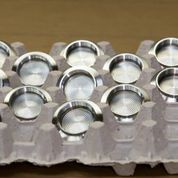Electropolishing

THE ELECTROPOLISHING PROCESS
Electropolishing is the controlled electro-chemical removal of surface metal, resulting in a significant brightening of the part surface and improved corrosion properties. Sometimes described as “reverse plating” or “super passivation,” the process has a leveling effect, which produces smoothness and increased reflectivity. More importantly, the deformed, amorphous outer layer of the metal is removed, leaving a chromium-rich, passive surface free of embedded contaminants and machining induced residual stresses. When properly performed, the process is completely safe, does not cause pitting or etching, and, in contrast to pickling or acidic cleaning, does not produce hydrogen embrittlement.
Electropolishing is accomplished by connecting the metal part to be processed to the positive side (the anode) of a DC power supply. The part is then immersed in a heated electrolytic (acidic) bath that contains metal plates connected to the negative side (the cathode). The electrical reaction causes an ionic conduction resulting in the removal of particles of metal from the anode.
During the process, the products of this anodic metal dissolution react with the electrolyte to form a film at the surface of the metal. This film essentially conforms to the general contour of the surface of the metal and therefore is thinner over the micro-projections and thicker at the micro-depressions. The result is more rapid dissolution of the micro-projections causing micro-leveling at the surface.
The amount of metal removed is influenced by the composition of the metal part to be electropolished, the temperature and agitation of the electrolytic bath, the spatial and area relationships of the anode and cathode, the current, and the length of time the current is flowing.
ELECTROLURGY’S ELECTROPOLISHING CAPABILITIES:
- Electropolish 300 and 400 Series, 17-4 PH
- Perform I.D. Electropolish (Requires Conforming Cathode)
- Typical Thickness Removal 0.0001 to 0.0003 Inches, up to 0.002 (Two Thousandths) possible
- Part Length Up to 4 Feet, 75 Pounds
- Masking available for selective polishing
- In-house salt spray testing per ASTM B 117
- Non-Destructive Testing (NDT) Available
APPLICABLE SPECIFICATIONS:
- Electrolurgy EPS-502
- ASTM B 912, Passivation of Stainless Steels Using Electropolishing
BENEFITS OF ELECTROPOLISHING
Better Physical Appearance
- Removal of fine directional lines from abrasive polishing.
- Excellent light reflection and depth of clarity.
- Bright, smooth polish; uniform luster of shaped parts.
Enhanced Mechanical Properties
- Less friction and surface drag.
- Increased production and duty cycles in process equipment. Electropolishing greatly reduces fouling, plugging, scaling and product build-up.
- Surface retains the true grain structure and properties of the bulk metal.
- Fatigue strength is not reduced. Electropolishing allows the true fatigue strength of a part to be accurately determined.
- Reduces galling of threads on stainless and carbon steel and other alloys.
Better Corrosion Protection
Electropolishing yields maximum tarnish and corrosion resistance in many metals and alloys. Stainless steel contains metallic and non-metallic inclusions, which are unavoidably included during fabrication. Mechanical polishing not only fails to remove inclusions, but also tends to push them further into the surface and even increase them by further pick-up of abrasive materials. These inclusions eventually can become points of corrosion.
Ease of Cleaning
- Significantly reduces product contamination and adhesion due to the microscopic smoothness of an electropolished surface (much like a glass surface).
- Decreases cleaning time. Electropolished surfaces can be effectively hydroblasted in less time and with less pressure. Some companies report that electropolished process equipment surfaces have reduced cleaning time by more than 50 percent.
- Improves sterilization and maintenance of hygienically clean surfaces for food, drug, beverage and chemical processing equipment.
- Provides best passivation of stainless steel.
- Decarburizes metals.
- Removes cold-worked metal oxides.
Other Benefits
- Simultaneously deburrs as it polishes.
- Radiuses or sharpens edges, depending on racking position.
- Polishes areas inaccessible by other methods.
- Reveals flaws in metal surfaces undetectable by other means. Electropolishing is one of the most effective inspection tools for judging metal surfaces.
- Provides a correct and reproducible microhardness on the metal surface.
- Allows micromachining of metal and alloy surfaces.
- Processes large numbers of parts simultaneously.
- Enables metal to be formed with fewer passes and annealing steps.
TYPICAL APPLICATIONS OF ELECTROPOLISHING:
- Medical Devices – Surgical Instruments, Catheters
- Aerospace – Stainless Steel Forgings (Reduce Roughness, Increase Corrosion Resistance)
- Industry – Process Control Equipment, Valves, Piping
- Marine – Increase brightness, remove embedded iron,
